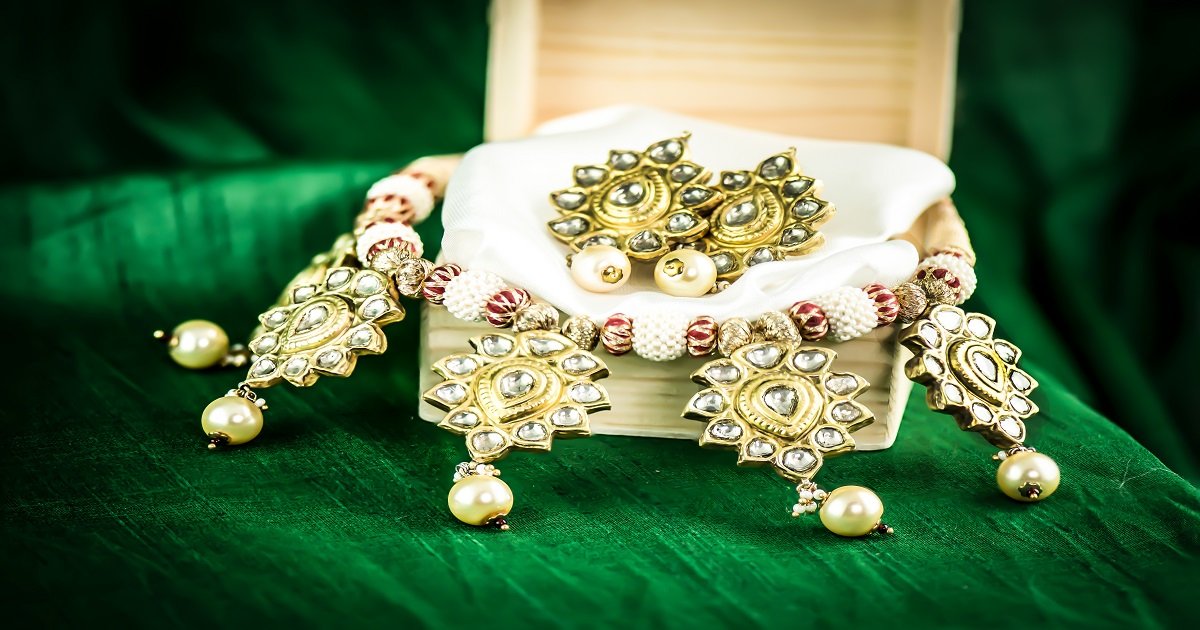Buying jewellery for your wedding?

Buying jewellery for your wedding?
Then this article will help you in your jewellery buying process.
Bridal jewellery shopping, although amazing, can be a tiresome process! The endless range of bridal jewellery offered can commonly lead to many complications on what to purchase. When it concerns Indian weddings, Kundan and Polki jewellery appears to be every bride-to-be's favourite option. May be you have enough knowledge of Kundan Polki Jewellery; nevertheless, in this article, we have tried our best to answer all those questions of brides and jewellery wearers, which are asked from time to time, like what is the difference between Kundan Polki and Jadau jewellery. Here, we break it down for you. What is the difference between Polki, Kundan and Jadau?
What exactly is Polki?
Polki is an unpolished, uncut diamond in its natural close-earth form, with one side level and the other side cut to a slightly convex and rounded shape.
What is the meaning of uncut?
"Uncut" means that these diamonds have not been cut or faceted to form geometric shapes as refined diamonds. They often are referred to as emerald-cut diamonds, cushion-cut diamonds, princess cuts, etc.
Faceted diamonds undertake numerous processing stages in their basic type to emit light and accomplish high-shine brilliance. Although un-cut diamonds don't shine like faceted diamonds, they have a distinct natural, charming attraction. Polki precious jewellery is gold foil with elaborate designs on the back, and these uncut diamonds are then protected with gold foil. As a result, Polki is a classic and timeless style of Indian fashion jewellery, making it an excellent financial investment usually passed down as antiques within households.
A brief history of this art of using uncut diamonds in jewellery goes back over 2500 years ago when it first came into India in the Mughals era, After which the art of making jewellery was introduced to the Rajputs' courts and eventually to the imperial family members across the country. Each royal adjusted the Polki technique to their version according to their preferences. Today, polki jewellery is still thought about as useful, which is seen in its normally high-priced cost. Today, it's Bikaner in Rajasthan where the most expertly hand-crafted polki method is used. The other place is known for polki jewellery after Rajasthan is Gujarat.
Three grades of polki
The most high-quality material is categorized as 'Syndicate Polki', which is used in the jewellery industry to describe top-grade Polki.
The next grade is called 'Zimbabwe'; as the name implies, this Polki comes from the Zimbabwean mines of Africa.
The third, the lowest grade Polki, is called 'Khilwas'.
These classifications explain the product's quality to ensure that customers can make an extra informed purchase.
The second important factor to be considered is the treatment. As with stones, Polki slices are treated to improve their appearance. Usually, filters are inserted in the slices to improve clarity and colour.
The fillings are typically 30%, 60% and 80%. Khilwas Polki is always treated because it otherwise looks fairly unattractive and would certainly be difficult to use. Large pieces in necklaces, pendants and lockets are generally set with 'Khilwas'.
What is Kundan Jewellery?
In the world of precious jewellery, the word Kundan has two meanings which is the reason for all the confusion for the non-professionals.
The meaning of Kundan relates to the gold foiling of 24 Karats applied to the base of the Kundan to hold the Glass or stones.
Kundan Jewelry is less costly than Polki jewellery since, in making Kundan jewellery, Glass is utilized. Glass is an alternative to diamonds that are used to lower the cost of jewellery. Yet, Kundan jewellery still makes use of silver or gold as its base metal, and, for that reason, this is classified as precious jewellery.
What is Jadau Jewellery?
Jadau doesn't refer to any stone or jewellery such as Kundan and Polki; however, it can be the instance. Jadau is the term used in the past for the technique of setting gold on Polki or Glass or various other stones. "Jad" is the word that "Jad" literally translates to embedding.
Hence, it is the art of setting 24 karat gold around stones known as Jadau, and the jewellery created from it is referred to as Jadau jewellery. In Jadau jewellery, the stones adhere to the gold without the help of any adhesive.
Polki stones are commonly used to make traditional Jadau jewellery as they are suitable for the rough-edged nature of Jadau. Because of the truth, Polki isn't cut as well and does not look clean or well-manicured like typical cut diamonds. Nonetheless, the polki is as valuable or pure as diamonds.
In short, Polki is the term used to define uncut rough diamonds. Kundan is the gold-plated strips put on the stones to make them established. Kundan is also a recommendation for a cheaper variation of polki, which uses Glass instead of diamonds. Jadau is the method of using the stones in Kundan or Polki Jewellery by making use of gold or silver.
Similar Blogs

How To Care for Your Wedding Jewellery

Buying jewellery for your wedding?

Types of Diamond Jewellery for Your Wedding Day
Recent Blogs
-
Types of Diamond Jewellery for Your Wedding Day
3 years ago
-
Buying jewellery for your wedding?
3 years ago
-
How To Care for Your Wedding Jewellery
3 years ago
Blog Archives